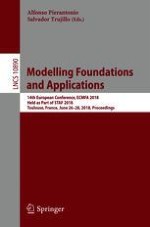2018 | Buch
Modelling Foundations and Applications
14th European Conference, ECMFA 2018, Held as Part of STAF 2018, Toulouse, France, June 26-28, 2018, Proceedings
herausgegeben von: Prof. Alfonso Pierantonio, Salvador Trujillo
Verlag: Springer International Publishing
Buchreihe : Lecture Notes in Computer Science
